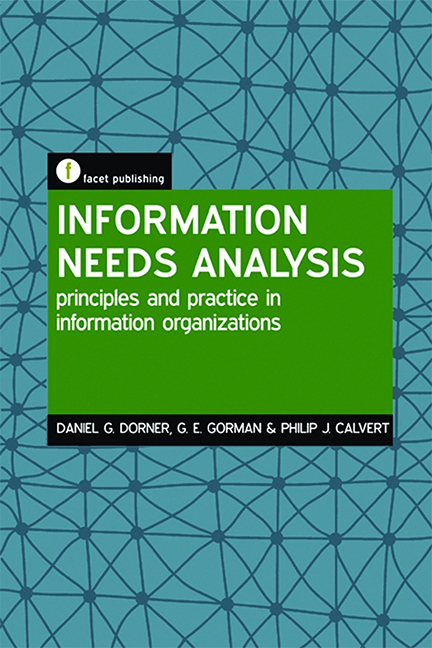Book contents
- Frontmatter
- Contents
- List of figures and tables
- List of scenarios
- About the authors
- Preface
- 1 Background to needs analysis for information managers
- 2 The importance of context in information needs analysis
- 3 Models and types of information needs analysis
- 4 The stages of information needs analysis
- 5 Gathering data for information needs analyses
- 6 Gathering data from existing sources
- 7 Gathering data through surveys
- 8 Gathering data through interviews
- 9 Analysing and integrating information needs analysis data
- 10 Reporting on an information needs analysis
- Bibliography
- Index
4 - The stages of information needs analysis
Published online by Cambridge University Press: 10 September 2022
- Frontmatter
- Contents
- List of figures and tables
- List of scenarios
- About the authors
- Preface
- 1 Background to needs analysis for information managers
- 2 The importance of context in information needs analysis
- 3 Models and types of information needs analysis
- 4 The stages of information needs analysis
- 5 Gathering data for information needs analyses
- 6 Gathering data from existing sources
- 7 Gathering data through surveys
- 8 Gathering data through interviews
- 9 Analysing and integrating information needs analysis data
- 10 Reporting on an information needs analysis
- Bibliography
- Index
Summary
Introduction
Following the definition of needs analysis in Chapter 1 –
information needs analysis is the process of making value judgements regarding solutions to an information-related problem faced by a client group, service provider or facility in order to facilitate fulfilment of a necessary, useful and defensible purpose
– we now turn to the practical elements of this definition. Specifically, needs analysis in information settings is a process that involves delineating, obtaining and applying information to determine what is needed to serve a specified (defensible) purpose. These three key words – delineating, obtaining, applying – are at the core of all needs analyses and should be evident throughout any INA activity or project.
In an information setting the needs analysis process should be seen as contributing to two essential activities in the proactive management of services, facilities and staff. First, the process should help determine what needs exist and how they might best be met. Second, the process should provide benchmark criteria for evaluating the merits of whatever is being investigated (systems, buildings, staff, services, collections) to determine the extent to which the specified needs are being met.
It is against the background of these activities that we set out to address three main questions in this chapter:
1 What are the principal stages of INA?
2 What are the main activities in each of these stages?
3 How are these activities interrelated?
Four stages of needs analysis
To meet the needs of either type of activity just noted the needs analysis process typically embodies a four-stage set of activities, with an additional pair of post-intervention activities that are not properly part of the analysis process; this process is visualized in Figure 4.1. An INA per se ceases when the data about the needs have been gathered and analysed, and a range of possible context-specific solutions suggested. Putting these solutions into operation and then evaluating the results belong properly to ex post analysis.
The recursive nature of INA research
Each of these four principal stages is now outlined in turn. However, the investigator must remember that this is not a strictly linear process and that in fact a number of activities may occur simultaneously because of the complexity of the target group, community or organization.
- Type
- Chapter
- Information
- Information Needs AnalysisPrinciples and Practice in Information Organizations, pp. 67 - 86Publisher: FacetPrint publication year: 2017



